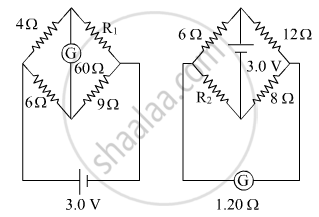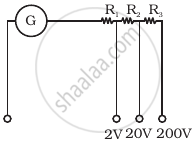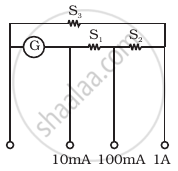Advertisements
Advertisements
प्रश्न
To convert a moving coil galvanometer into an ammeter we need to connect a ______.
पर्याय
small resistance in parallel with it
large resistance in series with it
small resistance in series with it
large resistance in parallel with it
उत्तर
To convert a moving coil galvanometer into an ammeter we need to connect a small resistance in parallel with it.
Explanation:
To turn a moving coil galvanometer into an ammeter, a low-resistance, known as a shunt, is connected parallel to the galvanometer. The shunt allows the majority of the current to bypass the galvanometer, allowing it to measure high currents without being harmed. This ensures that the galvanometer deflection is proportional to the total current in the circuit.
APPEARS IN
संबंधित प्रश्न
The combined resistance of a galvanometer of resistance 500Ω and its shunt is 21Ω. Calculate the value of shunt.
Write the underlying principle of a moving coil galvanometer.
Obtain the expression for current sensitivity of moving coil galvanometer.
A circular coil of 250 turns and diameter 18 cm carries a current of 12A. What is the magnitude of magnetic moment associated with the coil?
A galvanometer of resistance G is converted into a voltmeter to measure upto V volts by connecting a resistance R1 in series with the coil. If a resistance R2 is connected in series with it, then it can measures upto V/2 volts. Find the resistance, in terms of R1 and R2, required to be connected to convert it into a voltmeter that can read upto 2 V. Also find the resistance G of the galvanometer in terms of R1 and R2
Draw a labelled diagram of a moving coil galvanometer. Describe briefly its principle and working.
Explain how moving coil galvanometer is converted into a voltmeter. Derive the necessary formula.
A rectangular coil of a moving coil galvanometer contains 100 turns, each having area
15 cm2. It is suspended in the radial magnetic field 0.03 T. The twist constant of suspension
fibre is 15 x 10-10 N-m/degree. Calculate the sensitivity of the moving coil galvanometer.
With the help of a neat and labelled diagram, explain the principle and working of a moving coil galvanometer ?
Define current sensitivity of a galvanometer.
Why does a galvanometer when connected in series with a capacitor show a momentary deflection, when it is being charged or discharged?
How does this observation lead to modifying the Ampere's circuital law?
Hence write the generalised expression of Ampere's law.
Write current sensitivity of a galvanomete S.I. unit.
Figure shows two circuits each having a galvanometer and a battery of 3V.
When the galvanometers in each arrangement do not show any deflection, obtain the ratio R1/R2.

Explain, giving reasons, the basic difference in converting a galvanometer into (i) a voltmeter and (ii) an ammeter?
In the meter bridge experiment, balance point was observed at J with AJ = l.
(i) The values of R and X were doubled and then interchanged. What would be the new position of balance point?
(ii) If the galvanometer and battery are interchanged at the balance position, how will the alance point get affected?

State the principle of the working of a moving coil galvanometer, giving its labeled diagram ?
What are the advantages of using soft iron as a core, instead of steel, in the coils of galvanometers?
Why are the pole pieces of a horseshoe magnet in a moving coil galvanometer made cylinder in shape?
A moving coil galvanometer has a coil of resistance 59 Ω. It shows a full-scale deflection for a current of 50 mA. How will you convert it to an ammeter having a range of 0 to 3A?
State how a moving coil galvanometer can be converted into an ammeter.
Explain the significance of a radial magnetic field when a current-carrying coil is kept in it.
A galvanometer coil has a resistance of 15 Ω and the metre shows full scale deflection for a current of 4 mA. How will you convert the metre into an ammeter of range 0 to 6 A?
The current sensitivity of a galvanometer is defined as ______.
A moving coil galvanometer can be converted into an ammeter by ______.
The conversion of a moving coil galvanometer into a voltmeter is done by ______.
The coil of a moving coil galvanometer is wound over a metal frame in order to ______.
Assertion (A): On Increasing the current sensitivity of a galvanometer by increasing the number of turns may not necessarily increase its voltage sensitivity.
Reason (R): The resistance of the coil of the galvanometer increases on increasing the number of turns.
Select the most appropriate answer from the options given below:
A galvanometer of resistance 100 Ω gives a full-scale deflection for a current of 10−5 A. To convert it into an ammeter capable of measuring up to 1 A we should connect a resistance of ______.
In an ammeter 0.5% of main current passes through galvanometer; If resistance of galvanometer is G, the resistance of ammeter will be.
A multirange voltmeter can be constructed by using a galvanometer circuit as shown in figure. We want to construct a voltmeter that can measure 2V, 20V and 200V using a galvanometer of resistance 10Ω and that produces maximum deflection for current of 1 mA. Find R1, R2 and R3 that have to be used.

A multirange current meter can be constructed by using a galvanometer circuit as shown in figure. We want a current meter that can measure 10 mA, 100 mA and 1A using a galvanometer of resistance 10 Ω and that prduces maximum deflection for current of 1mA. Find S1, S2 and S3 that have to be used

A galvanometer coil bas 500 turns and each tum has an average area of 3 × 10-4 m2. If a torque of 1.5 Nm is required to keep this coil parallel to a magnetic field when a current of 0.5 A is flowing through it, the strength of the field (in T) is ______.
A moving coil galvanometer has 150 equal divisions. Its current sensitivity is 10-divisions per milliampere and voltage sensitivity is 2 divisions per millivolt. In order that each division reads 1 volt, the resistance in ohms needed to be connected in series with the coil will be ______.
A galvanometer shows full-scale deflection for current Ig. A resistance R1 is required to convert it into a voltmeter of range (0 - V) and a resistance R2 to convert it into a voltmeter of range (0 - 2V). Find the resistance of the galvanometer.
How is current sensitivity increased?
Assertion: When an electric current is passed through a moving coil galvanometer, its coil gets deflected.
Reason: A circular coil produces a uniform magnetic field around itself when an electric current is passed through it.
A galvanometer of resistance 100 Ω gives a full-scale deflection for a potential difference of 200 mV.
- What must be the resistance connected to convert the galvanometer into an ammeter of the range 0-200 mA?
- Determine resistance of the ammeter.
